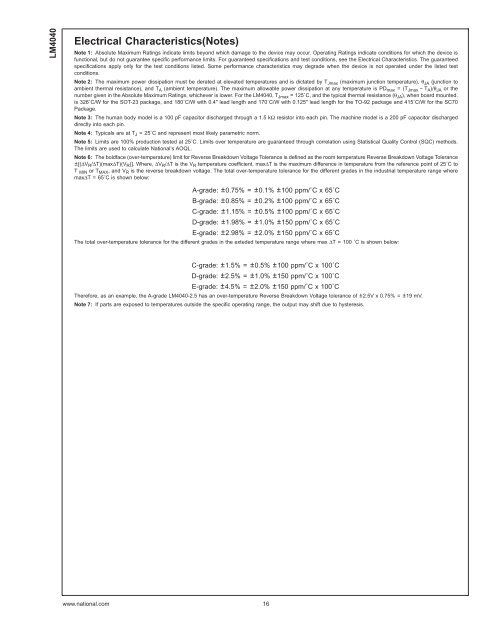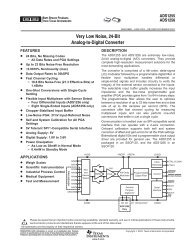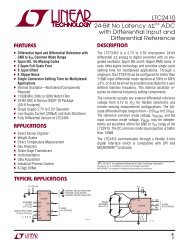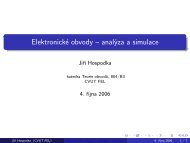LM4040 Precision Micropower Shunt Voltage Reference
LM4040 Precision Micropower Shunt Voltage Reference
LM4040 Precision Micropower Shunt Voltage Reference
You also want an ePaper? Increase the reach of your titles
YUMPU automatically turns print PDFs into web optimized ePapers that Google loves.
<strong>LM4040</strong><br />
Electrical Characteristics(Notes)<br />
Note 1: Absolute Maximum Ratings indicate limits beyond which damage to the device may occur. Operating Ratings indicate conditions for which the device is<br />
functional, but do not guarantee specific performance limits. For guaranteed specifications and test conditions, see the Electrical Characteristics. The guaranteed<br />
specifications apply only for the test conditions listed. Some performance characteristics may degrade when the device is not operated under the listed test<br />
conditions.<br />
Note 2: The maximum power dissipation must be derated at elevated temperatures and is dictated by T Jmax (maximum junction temperature), θ JA (junction to<br />
ambient thermal resistance), and T A (ambient temperature). The maximum allowable power dissipation at any temperature is PD max =(T Jmax −T A )/θ JA or the<br />
number given in the Absolute Maximum Ratings, whichever is lower. For the <strong>LM4040</strong>, T Jmax = 125˚C, and the typical thermal resistance (θ JA ), when board mounted,<br />
is 326˚C/W for the SOT-23 package, and 180˚C/W with 0.4" lead length and 170˚C/W with 0.125" lead length for the TO-92 package and 415˚C/W for the SC70<br />
Package.<br />
Note 3: The human body model is a 100 pF capacitor discharged through a 1.5 kΩ resistor into each pin. The machine model is a 200 pF capacitor discharged<br />
directly into each pin.<br />
Note 4: Typicals are at T J = 25˚C and represent most likely parametric norm.<br />
Note 5: Limits are 100% production tested at 25˚C. Limits over temperature are guaranteed through correlation using Statistical Quality Control (SQC) methods.<br />
The limits are used to calculate National’s AOQL.<br />
Note 6: The boldface (over-temperature) limit for Reverse Breakdown <strong>Voltage</strong> Tolerance is defined as the room temperature Reverse Breakdown <strong>Voltage</strong> Tolerance<br />
±[(∆V R /∆T)(max∆T)(V R )]. Where, ∆V R /∆T is the V R temperature coefficient, max∆T is the maximum difference in temperature from the reference point of 25˚C to<br />
T MIN or T MAX , and V R is the reverse breakdown voltage. The total over-temperature tolerance for the different grades in the industrial temperature range where<br />
max∆T = 65˚C is shown below:<br />
A-grade: ±0.75% = ±0.1% ±100 ppm/˚C x 65˚C<br />
B-grade: ±0.85% = ±0.2% ±100 ppm/˚C x 65˚C<br />
C-grade: ±1.15% = ±0.5% ±100 ppm/˚C x 65˚C<br />
D-grade: ±1.98% = ±1.0% ±150 ppm/˚C x 65˚C<br />
E-grade: ±2.98% = ±2.0% ±150 ppm/˚C x 65˚C<br />
The total over-temperature tolerance for the different grades in the exteded temperature range where max ∆T = 100 ˚C is shown below:<br />
C-grade: ±1.5% = ±0.5% ±100 ppm/˚C x 100˚C<br />
D-grade: ±2.5% = ±1.0% ±150 ppm/˚C x 100˚C<br />
E-grade: ±4.5% = ±2.0% ±150 ppm/˚C x 100˚C<br />
Therefore, as an example, the A-grade <strong>LM4040</strong>-2.5 has an over-temperature Reverse Breakdown <strong>Voltage</strong> tolerance of ±2.5V x 0.75% = ±19 mV.<br />
Note 7: If parts are exposed to temperatures outside the specific operating range, the output may shift due to hysteresis.<br />
www.national.com 16






